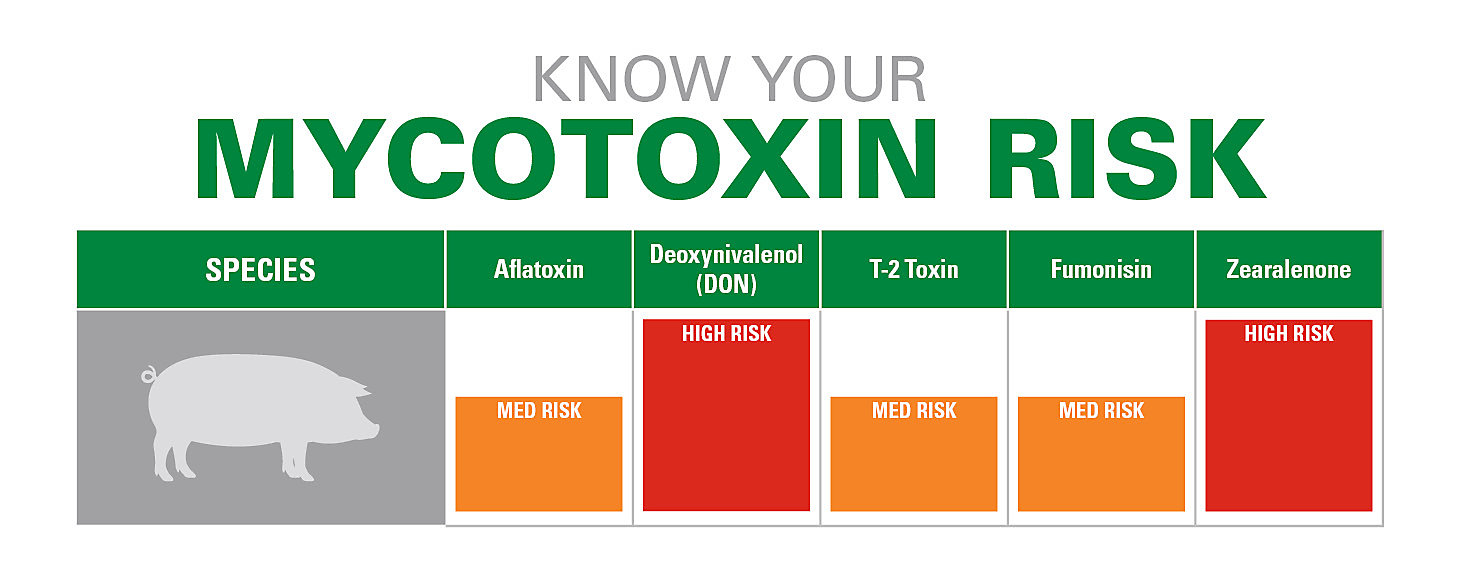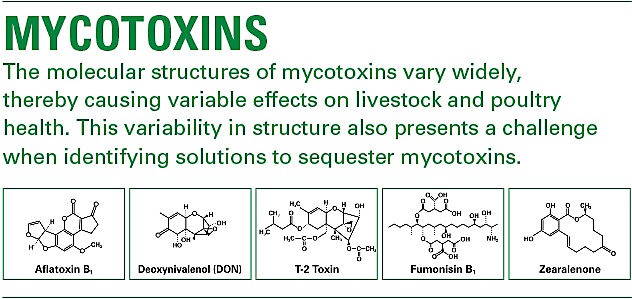The gastrointestinal (GI) tract is the first line of defense against mycotoxins ingested with feed. Under ideal circumstances, an animal's GI tract is equipped to handle mycotoxins without incurring damage. Tight junctions (TJ) between intestinal epithelial cells maintain barrier integrity and prevent toxins from infiltrating internal systems. Additionally, noninvasive microbiota and gut structures like cilia help move toxins through the digestive system before the interact with tissues and cause damage.
You are viewing United States
- United States
- Canada
- Mexico
- South America
- EMENA
- Sub-Saharan Africa
- Russia
- South Asia
- Asia Pacific
- China
- Global
Choose Your Location:
- United States
- Canada
- Mexico
Popular Searches
- Animal Nutrition & Health
- Intestinal Damage by Mycotoxins: An Often-Overlooked Factor in Gut Health Management
Intestinal Damage by Mycotoxins: An Often-Overlooked Factor in Gut Health Management
Livestock and poultry producers know that managing mycotoxins is anything but simple. With hundreds of mycotoxins, all produced by different fungi under different environmental conditions, management of these toxins is a moving target. Adding to the challenge, at levels as low as parts per billion (ppb) – a value equal to just one penny in $10 million – a single mycotoxin can detrimentally impact livestock performance. While the primary effects of major mycotoxins – aflatoxin, deoxynivalenol (DON), T-2 toxin, fumonisin and zearalenone – on performance and health of production animals are known, very little data exists regarding the health risk from multi-toxin exposure. This research gap is unfortunate for producers, because mycotoxin co-contamination in feed is generally the rule, not the exception.
Although numerous mycotoxin management solutions exist, many tackle only one specific toxin, making total control of multi-toxin contamination difficult to achieve. Worse yet, toxicity of individual toxins cannot be used to predict the pathogenicity of mycotoxin mixtures, and certain mycotoxin combinations may have additive or synergist effects.1 Researchers are still learning what combinations or levels of mycotoxins are most problematic. However, one conclusion is clear: damage to the intestinal barrier by mycotoxins – such as DON, T-2 toxin and fumonisin – opens the door for other diseases and illnesses, robbing animals of productivity and creating a costly management problem for producers.
Negative Effects of Mycotoxins on Intestinal Health

But, under the stress of common production environments, a breakdown in an animal's natural defenses can occur. When toxins interact with the intestine, they cause epithelial damage, which leads to a loosening of the TJ in gut tissue. This loosening is due to increased TJ protein expression, reduced transepithelial electrical resistance and increased paracellular transport, which allows more toxins and bacteria – like Escherichia coli and Salmonella – to enter other internal systems.2 Symptoms of mycotoxin damage to the intestine can range from diarrhea and reduced feed intake to death. Additionally, with over 70% of the immune system residing in the gut,3 mycotoxin damage can result in immune suppression, leading to a reduced ability of the animal to fight off infection and other diseases. Unfortunately, due to a lack of overt physical symptoms, mycotoxin damage to the intestine often goes largely undetected. Therefore, it is critical to implement a mitigation strategy to prevent significant reduction in animal performance, or economic outcomes will be impacted.
Mycotoxin Management Strategies to Safeguard Intestinal Health
Step one in developing a mycotoxin management strategy is to ask: "Which mycotoxins are in my feed?" Feed testing – which typically involves a certified laboratory evaluating multiple representative samples of feed – can help producers answer this question. Because every animal responds to different exposures and doses of mycotoxins, knowing which toxin is present in the feed sample is critical for controlling not only mycotoxin damage, but also the myriad of other illnesses and conditions they can cause.

Once the mycotoxin challenges are identified, producers can then evaluate mycotoxin solution options. While preventing mycotoxins from entering animals' GI tracts through the consumption of contaminated feed is the ideal solution, livestock producers and animal health professionals can most readily and practically prevent their damage by using additives that block consumed toxin molecules from impacting epithelial tissues inside an animal's GI tract. These compounds should have two key characteristics: first, the structural makeup that enables targeting of toxins, then the ability to effectively sequester and usher targeted toxins through the entire GI system to be excreted instead of allowed to bind with soft tissues in the gut lining.
This combination is readily available in KALLSIL™, an enhanced zeolite mineral-based feed supplement that, among other benefits, helps reduce the negative effects of molds and mycotoxins when an animal consumes contaminated feed. Importantly, KALLSIL provides broad-spectrum fungal metabolite control, with minimal binding of vitamins and minerals in feed, thereby supporting livestock and poultry performance. More information on KALLSIL and managing molds and mycotoxins is available online at Kemin.com/KALLSIL.
References
1Pierron, A., I. Alassane-Kpembi, and I.P. Oswald. 2016. Impact of two mycotoxins deoxynivalenol and fumonisin on pig intestinal health. Porcine Health Management. 2:21-29.
2Akbari, P., S. Braber, S. Varasteh, A. Alizadeh, J. Garssen, and J. Fink-Gremmels. 2017. The intestinal barrier as an emerging target in the toxicological assessment of mycotoxins. Arch. Toxicol., 91:1007-1029.
3Grenier, B. and T.J. Applegate. 2013. Modulation of intestinal functions following mycotoxin ingestion: meta-analysis of published experiments in animals. Toxins, 5:396-430.
Have a Question?
If you have a question about our products or services, or just want more information, fill out the form below and someone on our team will be in contact with you.
- California Residents
- California Supply Chain Act
- Canada Forced Labor and Child Labor Report
- Email Disclaimer
- GDPR Personal Data Addendum
- General Terms & Conditions for Vendors
- Global Environmental Policy Statement
- Indirect Cost Estimates
- Kemin Terms & Conditions
- Modern Slavery Act Transparency Statement
- Privacy Policy
- Sitemap
- Change Cookie Consent
- Animal Welfare Statement
© Kemin Industries, Inc. and its group of companies All rights reserved. ® ™ Trademarks of Kemin Industries, Inc., USA
Certain statements may not be applicable in all geographical regions. Product labeling and associated claims may differ based upon government requirements.
Thank you for visiting Kemin.com.
Your questions and feedback are important to us. Let us know how we can help you learn more about Kemin, our products, our services or our website.
Interested in starting a career with Kemin?
